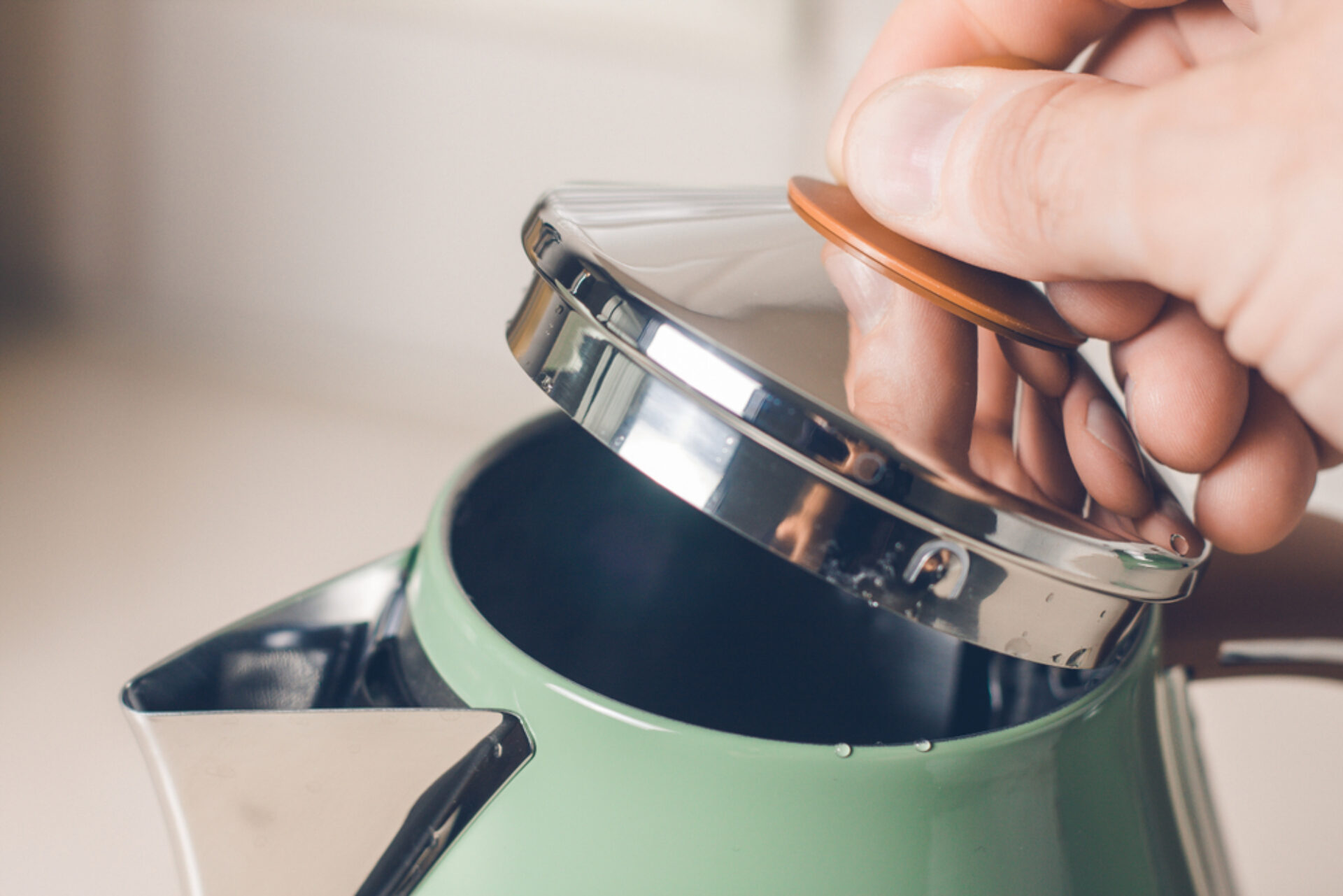Whether you own an electric kettle or a stovetop one, the inside of your kettle will gradually develop limescale the more you use it. These white calcium deposits inside there are both unsightly and unsavoury. And if neglected for long, limescale is destructive and can reduce the lifespan of your kettle. To ensure that it lasts longer, you need knowledge on how to descale a kettle.
Limescale is an old-age Inconvenience that is unlikely to be done away with any time soon. It may not harm you directly but will ensure that you replace your kettle repeatedly. In this post, we help you understand this kettle problem and how to solve it.

What causes limescale and how does it affect kettles?
Limescale mainly consists of calcium carbonate that is commonly found in rocks and seashells. It is mainly off-white in colour, grey, pink, or reddish-brown in some instances. Cases of limescale are mainly experienced in parts of the countries with hard water which contains high levels of magnesium and calcium.
A flaky and scaly coating that won’t disappear easily on its own is set to build up if you don’t know how to descale a kettle. This coating may cause the heating element in your kettle to become less effective. This means you will have to wait longer before your water gets ready, consuming more energy than normal.
Also, hot drinks made from water boiled in a limescaled kettle will tend to taste salty. That’s because elements that cause limescale like calcium and magnesium impact how flavours in drinks are broken down. You may also find pieces of limescale floating on drinks, which can get disgusting if you accidentally happen to crunch on one during your regular morning cuppa.
With technological advancements, improvements have been made to electric kettles to try to get rid of this problem. This includes fitting them with an element behind the metal base plate which helps reduce the risk of damage hence lengthen their lives. This technology also ensures that a limescale filter is placed in the spout to separate limescale from the water as you pour. Unfortunately, these efforts are not foolproof. Limescale still builds up and so knowing how to descale your kettle will remain important.

How to descale your kettle
A kettle is among the frequently used kitchen appliances but is often neglected when it comes to cleaning and regular maintenance. When cleaning becomes compulsory, you may find it to be a complex process. Here are a few precautions you have to take before you start descaling your kettle.
Ensure that you unplug your electric kettle from the source of power. To ensure safety, disconnect the base of your kettle from the main power supply and ensure that it is always dry throughout the descaling process.
Ensure that your kettle is cool before starting the cleaning. Descaling a kettle is usually done by hand wash and you don’t want to be washing a hot kettle!

How to descale a kettle with vinegar
Using vinegar is one way of descaling a kettle. To do this, fill it to three-quarters capacity with a solution of water and white vinegar. The water and vinegar should be mixed in a ratio of 1:1. Boil the solution. For rickety kettles with hard to access areas, you should let the mixture settle for at least thirty minutes.
Pour out the solution after at least thirty minutes and rinse out the kettle. For better results, ensure that you rinse your kettle two to three times. This helps to completely get rid of the vinegar out of the inside of your kettle.
Use a clean wet cloth to wipe away any limescale that might be left inside the kettle. In as much as the vinegar solution cleans, it may probably not clean all the limescale. The leftover limescale is removed by adding baking soda to a damp cloth and wiping by hand. To ensure better results, you are advised to use a microfiber cloth or a cleaning brush that will get all the corners of your kettle cleaned.
The last step of descaling your kettle with this method is by running a plain water cycle. This process is done by filling your kettle halfway with clean water and letting it boil for a few minutes. Pour out the water once it starts to boil and repeat the process 2 to 3 times until there is no lingering vinegar taste.

Using lemon juice to descale your kettle
Lemon acts as a natural stain remover; its juice is a bleaching and whitening agent. To descale your kettle using lemon juice, you are required to squeeze a lemon into approximately a 300 ml capacity cup and stir to mix. Cut the lemon into small pieces and add them to water as well then pour the mixture into your kettle and allow it to boil then discard the contents after boiling.
Again fill the kettle halfway full with the water and lemon juice mixture and plug your kettle into the source of power to heat the lemon water. Discard the solution and repeat the process for the third time.
This time around, allow your solution to boil for about a minute then unplug your source of heat and allow it to cool for at least one hour. If you don’t have time, thirty minutes is enough especially if the damage is minimal.
Rinse out your kettle using water mixed with lemon juice. This should be done about four to five times to ensure that all the limescale is removed as well as the smell of lemon juice. For maximum and better results, you are advised to remove the kettle lid to make it easier for you to rinse out under the sink faucet.

Descale your kettle with a descaling kit
Descaling kits and tablets are a quick, simple and fuss-free way to descale your kettle. You can buy descaling tablets in most supermarkets and online on sites like Amazon. They’re really easy to use and do most of the hard work for you!
Another quick alternative is investing in descaling kits. Descaling kits come in powder form packaged in packages like teabags. They work perfectly on scaled-up kettles and coffee machines by cleaning in under ten minutes – a quicker option than the home remedies.

Looking for a new kettle?
If you’re on the market for a new kettle, Swan is the best place to be. We offer plenty of quality kettles to choose from, including:
Frequently asked questions:
Is limescale dangerous if consumed?
Limescale is a naturally occurring substance that is not dangerous when consumed but it’s a serious appliance killer.
How can I test for limescale filters in my kettle?
The purpose of limescale filters is to prevent limescale particles from finding their way into your cup. To test for limescale filters, you should inspect if the limescale filter fits snugly into the spout of the kettle. If it fits well, no amount of limescale will pass through the filter. You should test it using small debris before you test it using your drink.
Since limescale is a procedural killer of appliances, knowing how to descale your kettle may help to elongate its lifespan. To stop limescale, you are required to use a water softener which will act by protecting harsh minerals from entering your water kettle. By doing so, you are assured of zero limescale chalky build-up in your kettle.


